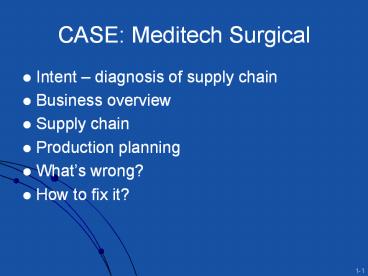CASE: Meditech Surgical - PowerPoint PPT Presentation
CASE: Meditech Surgical
1-1. CASE: Meditech Surgical. Intent diagnosis of supply chain ... How to fix it? 1-2. Endoscopic Surgical Instruments. Permits minimally invasive surgery ... – PowerPoint PPT presentation
Title: CASE: Meditech Surgical
1
CASE Meditech Surgical
- Intent diagnosis of supply chain
- Business overview
- Supply chain
- Production planning
- Whats wrong?
- How to fix it?
2
Endoscopic Surgical Instruments
- Permits minimally invasive surgery
- Market created in early 80s, rapidly growing
- Old products continually updated and replaced
with new product introductions
3
Business Overview
- National and Meditech split the market
- Compete based on product innovations, customer
service, cost - National sells to physicians Meditech sells to
material managers - Customer preferences change slowly
4
External Supply Chain
Hospitals
Domestic Dealers
Part suppliers
Meditech Assembly
Meditech Warehouse
Hospitals
Intl Meditech Affiliates
5
Internal Supply Chain
Packaging Sterilization
Parts Inventory
Assembly
Bulk Inventory
FG Inventory
2 - 16 weeks
1 week
2 weeks
6
Production Planning
Annual Forecast
Monthly Revision
Transfer Requirements
Monthly Plan
MRP
Parts Procurement Plan
Weekly Assembly Schedule
7
Production Planning
Monthly Plan
MRP
Order point Order quantity
Material Plan
Packaging Sterilization
Parts Inventory
Assembly
Bulk Inventory
FG inventory
8
Whats Wrong?
- Poor service for new product introductions
- Poor forecasting?
- Panic ordering?
- And high FG inventory
9
What Is Going On?
- Demand is quite predictable
- Usage in hospitals is quite stable
- Market share moves slowly over time
- With each new product, dealer must build
inventory to fill pipeline
10
Why Did Meditech Think Demand Was Unpredictable?
- Poor information systems
- No one looked at demand
- No one had responsibility for forecast errors
- Tendency to shift the blame
- Built-in delays and monthly buckets in planning
system - Amplifier in planning system
11
What to Do?
- Recognize that demand is stable and predictable
- Establish accountability for forecast
- Eliminate planning delays and/or reduce time
bucket - Alternatively, put assembly within pull system
and eliminate bulk inventory
PowerShow.com is a leading presentation sharing website. It has millions of presentations already uploaded and available with 1,000s more being uploaded by its users every day. Whatever your area of interest, here you’ll be able to find and view presentations you’ll love and possibly download. And, best of all, it is completely free and easy to use.
You might even have a presentation you’d like to share with others. If so, just upload it to PowerShow.com. We’ll convert it to an HTML5 slideshow that includes all the media types you’ve already added: audio, video, music, pictures, animations and transition effects. Then you can share it with your target audience as well as PowerShow.com’s millions of monthly visitors. And, again, it’s all free.
About the Developers
PowerShow.com is brought to you by CrystalGraphics, the award-winning developer and market-leading publisher of rich-media enhancement products for presentations. Our product offerings include millions of PowerPoint templates, diagrams, animated 3D characters and more.































